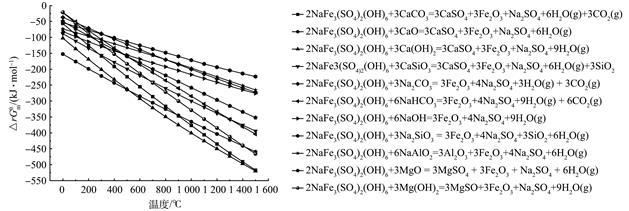| 利用铁矾渣制备轻质固硫陶粒 |
| |
| 引用本文: | 刘明坤, 孙振华, 李少鹏, 王晨晔, 李会泉, 张银亮, 陈欢. 利用铁矾渣制备轻质固硫陶粒[J]. 环境工程学报, 2022, 16(11): 3696-3704. doi: 10.12030/j.cjee.202205039 |
| |
| 作者姓名: | 刘明坤 孙振华 李少鹏 王晨晔 李会泉 张银亮 陈欢 |
| |
| 作者单位: | 1.中国科学院过程工程研究所 绿色过程与工程重点实验室 战略金属资源绿色循环利用国家工程研究中心,北京 100190; 2.中国地质大学 (北京) 材料科学与工程学院,北京 100083; 3.中国科学院大学 化学工程学院,北京 100049; 4.湖南邦普循环科技有限公司,长沙 410600; 5.湖南中邦再生资源科技有限公司,长沙 410600 |
| |
| 基金项目: | 国家重点研发资助计划 (2018YFC1901803) ;中国科学院重点部署资助项目 (ZDRW_CN_2020-1) ;中国科学院青年促进会资助项目 (2021045) ;中国科学院绿色制造创新研究院自主部署项目 (IAGM-2019-A15) |
| |
| 摘 要: | 
铁矾渣是锂电回收过程黄铁矾法除铁产生的废渣,高温条件下易分解产生二氧化硫。通过在铁矾渣中添加固硫剂制备固硫陶粒是实现铁矾渣合理利用的有效途径。通过计算高温环境下不同氧化物吉布斯自由能,并结合固硫剂铁矾渣混合焙烧实验,确定固硫效果较优的氧化钙作为固硫陶粒的固硫剂;同时,考察固硫剂掺量对固硫陶粒的固硫效果及性能的影响。结果表明,随着固硫剂掺量增加固硫率上升,固硫陶粒的吸水率和抗压强度先增加后减少,堆积密度和表观密度先减少后增加。
当Ca/S 比为 2.35时,固硫陶粒的固硫率达到最高48.8%,吸水率为3.89%,抗压强度为0.79 MPa,表观密度和堆积密度分别为0.72 g·cm-3和0.51 g·cm-3。通过XRD和TG-DSC-FTIR分析固硫机理,发现硫酸盐通过与固硫剂相互作用形成了分解温度更高的CaSO4和K2SO4。固硫陶粒的毒性浸出实验结果符合国家标准。本研究结果可为铁矾渣的高值环保利用的相关研究提供参考。

|
| 关 键 词: | 固硫剂 固硫机理 铁矾渣 重金属固定 氧化钙 |
| 收稿时间: | 2022-05-09 |
|
| 点击此处可从《环境工程学报》浏览原始摘要信息 |
|
点击此处可从《环境工程学报》下载全文 |
|



